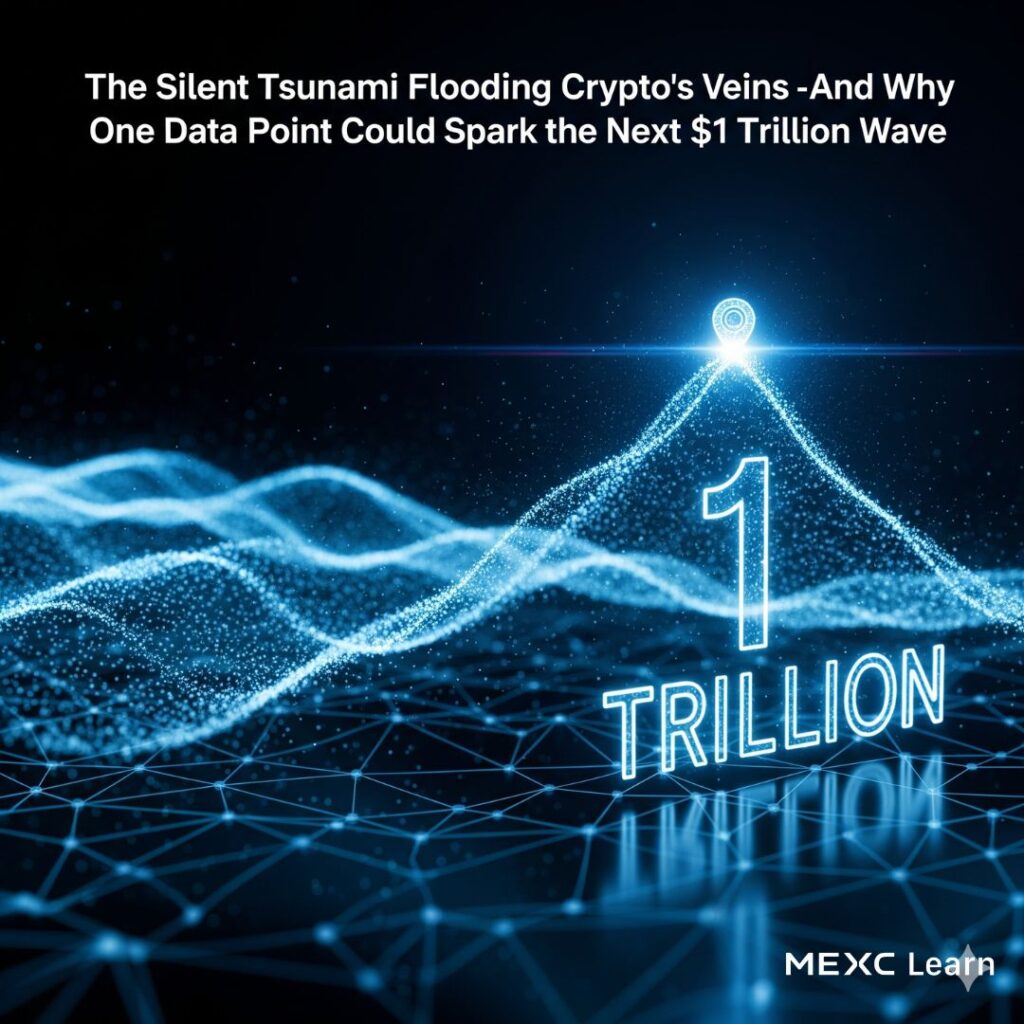
On September 20, 2025, while Bitcoin‘s teasing $116,000 and meme coins are doing their usual circus act, something quieter, almost invisible, is reshaping the entire crypto ocean. Stablecoins, those unassuming digital dollars, aren’t just sitting pretty anymore. They’re surging through blockchains like a hidden current, powering $27 trillion in annual transfers that dwarf Visa and Mastercard combined. Last year alone, they processed $5.7 trillion in transactions, with Q1 2025 spiking 66% to kick off the year on steroids. But here’s the hook: Amid Fed rate cuts and regulatory green lights, one overlooked metric – the interplay of net flows, blistering volumes, and funding rates – is flashing signals of a potential explosion. Could stablecoins be the “silent tsunami” that finally drags traditional finance under? Or are they the life raft in a storm of volatility? In this Data Watch, we’ll dive into the numbers, unpack the trends, and hunt for that one clue that might predict the next mega-rally. Spoiler: It’s hiding in plain sight, and by the end, you’ll see why your next trade might hinge on it.
Let’s start with the basics, but with a twist. Stablecoins aren’t sexy like a 10x altcoin pump, but they’re the grease in crypto’s engine. Pegged to the dollar (or gold, or whatever), they let you park cash on-chain without the BTC rollercoaster. In 2025, their market cap has ballooned to $252 billion by mid-year, up from $204 billion at the start, a 24% sprint that’s got even skeptics raising eyebrows. Tether’s USDT rules the roost at $150 billion+, with Circle’s USDC nipping at its heels around $70-75 billion. But don’t sleep on the dark horses: Decentralized darlings like DAI ($6.7 billion) and newcomers like Ripple’s RLUSD are carving niches, especially in DeFi where they fuel $60 billion in lending alone. The real story? It’s not the cap; it’s the movement. These “stable” beasts are anything but static, they’re the blood pumping through crypto’s veins, and the data screams expansion.
1.Net Flows: The Invisible Capital Pump
If stablecoins are the blood, net flows are the heartbeat. Picture money sloshing in and out of exchanges and chains like tides in a bay. Positive net flows (more in than out) signal fresh capital entering the ecosystem, think institutions dipping toes or retail FOMO kicking in. Negative? That’s flight mode, often tied to redemptions or profit-taking.
Zoom into 2025: Global stablecoin supply jumped 59% last year to over $200 billion, hitting an all-time high in September 2024 before accelerating further. Fast-forward to now, and we’re seeing wild regional splits. North America leads with $633 billion in total flows, but it’s a net exporter, pumping $18.58 billion outward to satisfy global dollar thirst, especially when the greenback strengthens. Asia-Pacific? A beast at $519 billion total, with inflows of $407 billion barely edging outflows of $395 billion, plus $209 billion swirling intra-regionally, a hotbed for trade settlements and DeFi plays.
Relative to GDP, though? Emerging markets steal the show. Latin America and the Caribbean clock 7.7% of GDP in flows, while Africa and the Middle East hit 6.7% – places where stablecoins aren’t just crypto toys; they’re remittances on rocket fuel, slashing fees by 30-60% versus banks. Ethereum’s a flow magnet, hosting $166 billion in supply (up 11% monthly), with USDT alone at $87.8 billion. But watch Solana and Tron: They’re snagging share with faster, cheaper transfers, fragmenting the flow party via bridges and L2s.
The table below breaks down Q1-Q3 2025 net flows by major stablecoin (estimates from Chainalysis and DeFiLlama data). Notice the pattern: USDC’s rebounding from a $100 million February redemption to $248 million issuance in March – a sign of institutional trust post-GENIUS Act.

These flows aren’t random; they’re dollar demand in disguise. When local currencies wobble, North American outflows spike – a flight-to-safety play that’s juiced stablecoin growth 45x since 2019. On X, traders are buzzing: “Stablecoin inflows to exchanges just hit $10B weekly – Fed cut incoming, alts next?” one post quips, echoing the sentiment that positive flows are the canary in the bull coal mine. But beware: High mobility (over 50% of supply held <1 month) means flows can flip fast. If redemptions hit, it’s a liquidity crunch waiting to happen.
2.Volumes: The $27 Trillion Juggernaut Crushing Legacy Rails
Now, the adrenaline: Volumes. Stablecoins aren’t hoarding; they’re hauling. 2024’s $27.6 trillion in transfers already outpaced Visa/Mastercard’s combined haul, and 2025’s on track to smash it. H1 alone? $8.9 trillion on-chain, with daily peaks at $20-30 billion, that’s remittances and settlements on steroids, hitting 3% of the $200 trillion cross-border pie by Q1. Ethereum dominates 70% of supply and circulation, but Solana’s weekend volumes (yes, weekends – stablecoins don’t sleep) average billions daily, outpacing weekdays thanks to 24/7 DeFi.
USDT’s the volume king: $20-25 billion daily, mostly Asia/Europe trades. USDC? North America’s fave, with $3 trillion YTD on Ethereum alone. Gold-backed niches like PAXG? Volumes soared in March to yearly highs, market cap at $1.4 billion amid RWA hype. And yield-bearers? They’re exploding – 3% of market cap, up 414% in tokenized treasuries.
Here’s a snapshot of monthly volumes (trillions USD, adjusted for bots/internal transfers):Source: Aggregated from Artemis, Visa, DeFiLlama. What’s eye-popping? 80% of CEX trades pair with stables, and remittances? Now 2-3% fees vs. banks’ 6% – a $10B+ savings globally. X

chatter nails it: “Stable volumes > Visa? That’s not a flex; that’s the future of money.” But volumes this high mean fragility – one peg wobble (remember UST?), and it’s cascade city.
3.Funding Rates: The Hidden Tax (or Tip) on Leverage Dreams
Enter funding rates, the sneaky fee that keeps perpetual futures honest. Positive rates? Longs pay shorts to anchor prices to spot. Negative? Shorts foot the bill. In crypto’s leverage playground, they’re the thermostat, and in 2025, they’re heating up.
Post-Fed’s September 17 cut (25bps to 4-4.25%), rates flipped: BTC at 0.20%, ETH at 0.48% – bullish signal, as longs pay up amid liquidity hopes. Early 2025 saw negatives during corrections, handing shorts thousands daily even as prices ticked up. Now? With $4.17T market cap and Fed easing, positives dominate, discouraging over-leverage but fueling stablecoin parking for yields.
Tie it to stables: Yield-bearing ones like sUSDf (10% APY via funding arb) are exploding, capturing rates without impermanent loss. Protocols like YieldFi tap Morpho’s $60B liquidity for 5-10% APYs – stablecoin maxis’ dream. On X: “Funding rates + inflows = BTC run; else equities steal the show.” The data watch? If rates stay positive >0.3% with flows >$10B weekly, alts ignite. Flip negative? Brace for dumps.
4.The Interplay: Flows + Volumes + Rates = The Perfect Storm?
Here’s the magic (or mayhem): These metrics don’t dance alone. Surging volumes ($8.9T H1) feed flows ($30B+ Q3 YTD), which juice funding rates as leverage piles in. Post-GENIUS Act (1:1 reserves mandated), USDC’s issuance rebounded, stabilizing flows amid $559M insurance funds. But risks lurk: 98% bot volume on Solana/Base? Noise in the signal. Quantum threats from Solana’s Anatoly? A 50/50 peg cracker by 2030.
The killer clue? Watch Ethereum’s stable supply ($166B) vs. funding rates. If volumes hold $5T/month and rates >0.2%, we’re eyeing $300B cap by year-end – a 20% pop that could cascade to BTC $135K. X traders agree: “Flows to exchanges + low rates = liquidity tsunami.” Emerging markets (50% volume) amplify it remittances alone could add $10B quarterly.
5.The Verdict: Ride the Wave or Get Soaked?
Stablecoins in 2025? They’re not silent anymore, they’re the roar beneath the surface, with $252B cap, $27T+ volumes, and flows dictating the next bull leg. Funding rates are the spark: Positive persistence means longs pay up, but yields lure stables into action. The data watch? That $10B weekly inflow threshold, cross it with rates >0.3%, and alts moon. Miss it? Equities siphon the juice.
As Fed cuts weaken the dollar, stables aren’t just safe harbors; they’re the fleet leading the charge. I’ve watched flows flip markets before – this feels like 2021 redux, but with regs as tailwinds. Your move: Stack USDC for yields, eye net flows on CryptoQuant, or bet on funding arb plays. Whatever it is, don’t blink the tsunami’s cresting.
Disclaimer: This article is for informational purposes only and does not constitute financial advice. Cryptocurrency markets, including stablecoins, are highly volatile and involve significant risks, including potential loss of principal. Always conduct your own research and consult a financial advisor before investing or trading.
Join MEXC and Get up to $10,000 Bonus!
Sign Up


